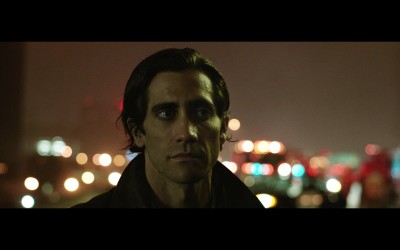Nightcrawler: shots that create empathy

All stills are property of their respective owners and are used here strictly for educational purposes only.
Most critical attention on 2014’s Nightcrawler centered on Jake Gyllenhaal’s lead performance. It’s understandable; Gyllenhaal’s character actor eccentricities gel together in a way we’ve rarely seen before. He’s intense and deeply unsettling as lead character Lou Bloom.
However, it’s smart cinematography that underlines his performance and sets the film’s dark, gritty tone. DP Robert Elswit forces the audience to empathize with Lou’s own sociopathic worldview.
Nightcrawler chronicles Lou’s growing career in L.A. crime journalism. Along the way we get a handful of conventionally filmed conversations with Lou at diners, cars, and TV stations. But crime scenes are the heart of the film and push the story forward. It’s also where Elswit makes many strong and unconventional shot choices.
Follow shots
As we arrive at each crime scene, Elswit immediately confounds our expectations. Most films would start things off with a wider establishing shot. Or we’d jump to medium length shots of the crime victims or other key actors. These shots orient the audience. They place us in a more neutral and dispassionate perspective.
Nightcrawler has different plans. When Lou exits the vehicle, we almost always start with a follow shot. As the name suggests, it’s a shot that pursues Lou from behind the back at a relatively constant distance.



It’s a simple technique that forces us to consider the action from Lou’s perspective. We see what he sees. With follow shots we’re also able to see our subject react to what’s unfolding onscreen. That deepens our empathy with Lou.
Follow shots are well established, especially since the introduction of the Steadicam in the mid 70s. Several long follow shots – The Shining’s tricycle ride, Goodfellas’ Copacabana walk – are treasured among cinephiles. Given their impact, most films use tracking shots sparingly. Yet Elswit relies on this technique throughout Nightcrawler. And he underlines the effect by placing Lou prominently in the frame.
It speaks volumes about the film. Lou’s the “hero” of his own movie. Elswit and director/writer Dan Gilroy want to make sure we experience this ride through his viewpoint.
Lou in isolation
After these opening tracking shots, Nightcrawler again mixes things up. There’s no cutting to a third character, a larger establishing shot, or a cut-in to a relevant detail for the audience. Instead, we usually reverse the follow shot to a mid or closeup shot on Lou. It’s rarely Lou interacting with other characters. Lou is alone with his camera, surveying the action.


The crime scenes get progressively wilder. From scene to scene, Lou is moving up the ladder. He’s gaining skills, upgrading his equipment, and nabbing larger crime scenes. He’s also increasingly comfortable committing larger crimes in the process.
Despite all that, Lou’s expressions and behavior in these shots rarely change. He remains focused on his task, rarely breaking out into much emotion. His eyes widen and dart around but almost never blink. Most of this naturally stems from Gyllenhaal’s acting. Yet cinematography forces the audience to stay trained on him. We go from what Lou sees to Lou’s reaction with little in between.
Shallow depth of field, frames within frames
Basic photography dictates the shallower the depth of field, the larger the aperture and the less light needed for scene coverage. That suits Nightcrawler, a low budget film shooting at night, mainly using available light. It’s also creative choice that magnifies the qualities of shots behind and in front of Lou.
Shallow shots of Lou help isolate him away from others, and we see that effect throughout the film. It’s increasingly apparent in late scenes. Lou’s intensely focused on his camera viewfinder, and Nightcrawler’s camera snaps to it as well. Focus is usually so shallow on the viewfinder that it’s hard to recognize anything else in the frame.

It’s another way to show how the audience is viewing the world through Lou’s eyes.
The home invasion
At the film’s midway point, Lou and Rick arrive at an apparent home invasion still in progress. It’s one of Nightcrawler’s longest and tensest scenes. It’s also the film’s best showcase for noted cinematography techniques: tight shots on Lou with a shallow depth of field.





Postscript
Artistic vision aside, cinematographers still have to manage time and budget. Nightcrawler had 40 filmed locations in 26 days, mostly at night on location in L.A. That’s a big challenge, even for a cinematographer as talented as Elswit. The tracking shots covered here lend themselves well to a fast, mobile shoot.
Even with ten times the time and budget, I suspect Nightcrawler would be filmed in a similar fashion. It’s gritty, unrelenting, and a hundred percent pure Lou Bloom. Robert Elswit and Dan Gilroy wouldn’t have it any other way.